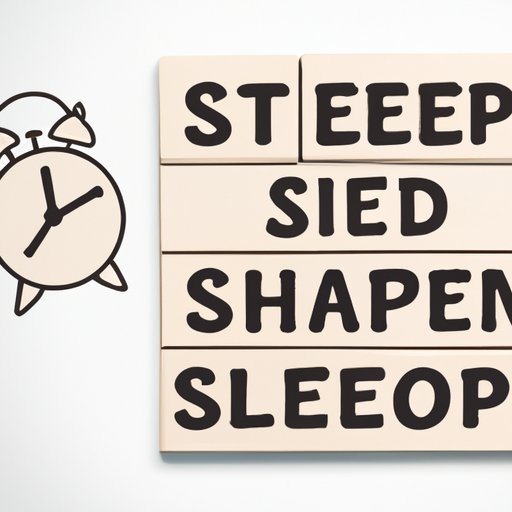
I. Introduction
Sleep is an essential aspect of everyone’s life. Getting enough rest is crucial for our overall health and wellbeing. However, aside from its well-known benefits, there are myths surrounding sleep that we need to debunk. One of them is the belief that sleeping can make you taller. Can sleeping improve your height growth potential, or is it just a myth? In this article, we explore the science between sleeping and height growth while debunking common myths associated with this topic.
II. The Science Behind Sleeping and Growing Taller
The link between proper sleep and growing taller is an essential scientific fact. The pituitary gland, a pea-sized gland situated at the base of our brain, secretes growth hormones while we are asleep. Growth hormones such as somatotropin stimulate our body’s overall growth, including bone growth. Therefore, getting enough sleep is crucial in maximizing our height potential.
A study published in the Journal of Clinical Endocrinology and Metabolism found a direct correlation between the duration of sleep and growth hormone production in both children and adults. This research shows that the amount of sleep a person gets each night could directly affect their growth and development.
To optimize your sleep quality for height growth potential, ensure that you get between 7-9 hours of sleep each night. Giving your body enough time to produce growth hormones is vital. Furthermore, maintaining a regular sleep schedule and creating a sleep-conducive environment can improve the overall quality of your sleep.
III. Common Myths About Sleeping and Height Growth Debunked
Several myths surround the connection between sleeping and height growth that we need to debunk. One of them is the notion that certain sleeping positions can make you taller. Sadly, there’s no scientific evidence to support this claim. Our sleeping position has no effect on our overall height.
Another common myth is the belief that stretching before bed can increase your height. There is no evidence to support this claim. However, stretching is still beneficial to our overall health by promoting muscle flexibility and reducing injury risk.
It’s also essential to note that genetic factors and nutrition play a more significant role in adult height than sleeping habits. While sleeping is vital for optimizing your height growth potential, these other factors are more crucial.
IV. The Importance of Good Sleep Habits for Children’s Growth and Development
It’s important to establish healthy sleep habits in children at an early age. Children who get enough sleep are more likely to have a healthy physical and mental development. The American Academy of Pediatrics recommends that newborns to one-year-old babies get between 12-16 hours of sleep, while toddlers between 1-3 years should sleep for about 11-14 hours each day. Children aged 3-5 years should sleep for 10-13 hours, and those aged 6-12 years should get between 9-12 hours of sleep per day.
An article published in the journal Osteoporosis International confirmed that sleep is essential in determining childhood growth patterns. Children’s brain releases growth hormones while they’re asleep, which affect their growth and development. Therefore, creating a sleep-conducive environment for children is crucial to promoting their physical and mental growth.
Parents can help their children establish healthy sleep habits by establishing a regular sleep schedule and reducing screen time before bed. Furthermore, creating a comfortable sleep environment such as a quiet, dark, and cool room can improve the overall quality of a child’s sleep.
V. Can Sleeping Help You Overcome Short Stature?
While getting enough sleep is essential to optimize your height growth potential, it’s not possible to increase your height through sleep alone. Your genetics, gender, and nutrition play a more significant role in determining your ultimate height. Furthermore, certain medical conditions such as hypothyroidism and growth hormone deficiency can also affect a person’s overall height.
If you’re unhappy with your height, there are other safe and effective solutions to help you overcome it. For example, certain exercises such as yoga and swimming can promote good posture, which in turn creates the illusion of being taller. Wearing high heels, choosing clothing with vertical stripes, and making sure that your hairstyle adds to your height are other tricks that can create an impression that you’re taller than you actually are.
VI. Maximizing the Benefits of Sleep for Fitness and Height
Getting enough sleep is crucial to achieving overall fitness and maximizing height growth potential. During sleep, our body recuperates by repairing cells and tissues. Furthermore, getting enough sleep is essential to muscle development and recovery.
For athletes and fitness enthusiasts, sleep should be an essential part of their overall training. Lack of sleep can lead to fatigue, increased risk of injuries, and reduced performance. Ensuring that you get between 7-9 hours of sleep each night can improve your physical performance and maximize your overall training potential.
To maximize the benefits of sleep for fitness and height growth, ensure that you establish a regular sleep schedule and create a comfortable sleep environment. Furthermore, engage in relaxing activities before bed such as meditation or reading a book to promote a restful and deep sleep.
VII. Conclusion
In conclusion, the connection between sleeping and height growth is an essential scientific fact. Getting enough sleep is crucial in maximizing your height potential. However, there are several myths surrounding this topic, such as the belief that sleeping can make you taller or that certain sleeping positions can affect your height growth. While these claims are not true, it’s vital to establish healthy sleep habits and maintain a regular sleep schedule to promote overall health and well-being.
Remember, creating a sleep-conducive environment and getting between 7-9 hours of sleep each night can provide numerous benefits such as improved physical performance, proper muscle development and recovery, and maximizing height growth potential.





